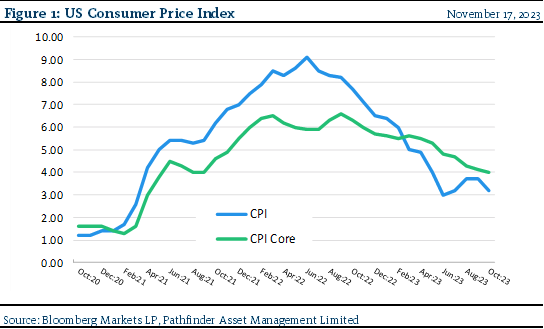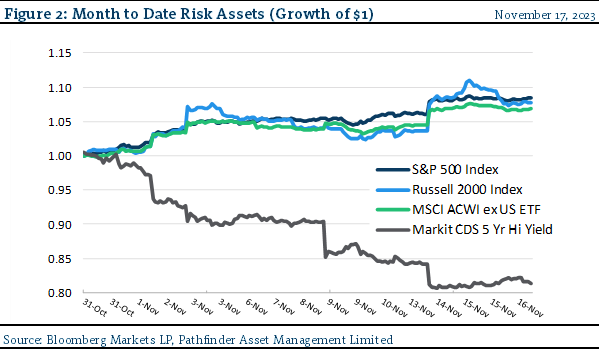Adding CPI and Retail Sales Data
Over the past couple of weeks, we have been writing about our evolving thesis with respect to softening economic data. We believe, at the margin, a measured slow down could lead major central banks around the world to “err on the side of caution” with respect to setting financial conditions. We concluded that recent US Central Bank commentary, with respect to the high level of rates, along with global data that we have been following, indicates that the major global economies are slowing. A subsequent and potential soft landing would thus be good for risk assets. We also noted that we would continue to watch closely as more data was released. This week we received softening Consumer Price Inflation (CPI) and weak Retail Sales data, which further confirms our thesis. Many readers might have noticed that equity markets have been strong since the beginning of the month. We believe that other investors are pricing in a similar scenario.
- Figure 1 presents quarterly CPI data, both at the headline and core levels (i.e. no food and energy). As you can see, the data peaked mid-2022 and has since fallen. Month-on-month CPI at the core level was also below expectations.
- What drove the market higher this week was the slowing month-on-month core data noted above as well as weak retail sales data. Both point to a slowing consumer economy, which is important as the consumer is two thirds of US GDP.

- Figure 2 presents the market reaction since the beginning of the month. The change in “the market view” given how far and how quickly risk assets (global large and small cap equities, along with credit default swaps) have come.

“This means that” our thesis continues to evolve in a more constructive way. Our view, and this is also implied by the futures market, is that the rate cuts will start this coming spring. That, in combination, with a potential soft landing and decreasing geopolitical tensions could provide a good set up for 2024, given how our portfolios are positioned now.
National Instrument 31-103 requires registered firms to disclose information that a reasonable investor would expect to know, including any material conflicts with the firm or its representatives. Doug Johnson and/or Pathfinder Asset Management Limited are an insider of companies periodically mentioned in this report. Please visit www.paml.ca for full disclosures.
Changes in Leverage. We are increasing the asset ceiling to 2.0 times the market value of equity for Pathfinder International Fund and Pathfinder Real Fund to be consistent with Pathfinder Partners’ Fund and Pathfinder Resource Fund.
*All returns are time weighted and net of investment management fees. Returns from the Pathfinder Partners’ Fund and Partners’ Real Return Plus Fund are presented based on the masters series of each fund. The Pathfinder Core: Equity Portfolio and The Pathfinder Core: High Income Portfolio are live accounts. These are actual accounts owned by the Pathfinder Chairman (Equity) and client (High Income) which contain no legacy positions, cash flows or other Pathfinder investment mandates or products. Monthly inception dates for each fund and portfolio are as follows: Pathfinder Core: Equity Portfolio (January 2011), Pathfinder Core: High Income Portfolio (October 2012) Partners’ Fund (April 2011), Partners’ Real Return Plus Fund (April, 2013), and Partners’ Core Plus Fund (November 2014).
Pathfinder Asset Management Limited (PAML) and its affiliates may collectively beneficially own in excess of 10% of one or more classes of the issued and outstanding equity securities mentioned in this newsletter. This publication is intended only to convey information. It is not to be construed as an investment guide or as an offer or solicitation of an offer to buy or sell any of the securities mentioned in it. The author has taken all usual and reasonable precautions to determine that the information contained in this publication has been obtained from sources believed to be reliable and that the procedures used to summarize and analyze such information are based on approved practices and principles in the investment industry. However, the market forces underlying investment value are subject to sudden and dramatic changes and data availability varies from one moment to the next. Consequently, neither the author nor PAML can make any warranty as to the accuracy or completeness of information, analysis or views contained in this publication or their usefulness or suitability in any particular circumstance. You should not undertake any investment or portfolio assessment or other transaction on the basis of this publication, but should first consult your portfolio manager, who can assess all relevant particulars of any proposed investment or transaction. PAML and the author accept no liability of any kind whatsoever or any damages or losses incurred by you as a result of reliance upon or use of this publication.